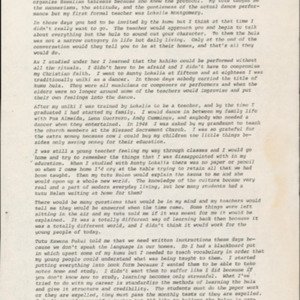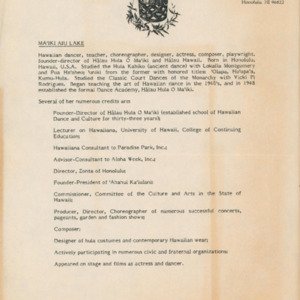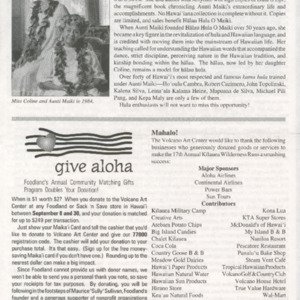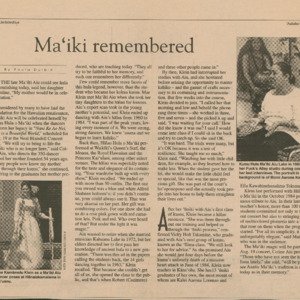Ma‘iki Aiu Lake and Coline Kaualoku Aiu Ferranti
Title
Ma‘iki Aiu Lake and Coline Kaualoku Aiu Ferranti
Description
Mā‘iki Aiu Lake
Mā’iki Aiu Lake, teacher of the hula for thirty-seven years, is recognized as a mentor for many of Hawaiʻi’s outstanding young kumu hula.
As far as my family was concerned the hula was a closed book. I came from a straight- laced, Christian family and most anything Hawaiian was not condoned. But in my family was a grandaunt named Helen Correa and to her the hula was great people accomplishing heroic deeds in everyday life. In the old days pageants were known as tableaus and she would be called upon by churches to organize Hawaiian tableaus because she knew the protocol. My tūtū taught me the mannerisms, the attitude, and the gentleness of the actual dance performance but my first formal teacher was Lokalia Montgomery.
As I studied under her I learned that the kahiko could be performed without all the rituals.
I didn’t have to be afraid and I didn’t have to compromise my Christian faith. I went to Aunty Lokalia at fifteen and at eighteen I was graduated traditionally as a dancer. In those days nobody carried the title of kumu hula. They were all musicians or composers or performers and when the elders were no longer around some of the teachers would improvise and put their own feelings into the dance.
After my ‘ūniki I was trained by Lokalia to be a teacher and by the time I graduated I had started my family. I would dance in between my family life with Pua Almeida, Lena Guerrero, Andy Cummings, and anybody who needed a dancer when they entertained. In 1946 I was asked by my grandaunt to teach the church members at the Blessed Sacrament Church. I was so grateful for the extra money because now I could buy my children the little things besides only saving money for their education.
I was still a young teacher feeling my way through classes and I would go home and try to remember the things that I was disappointed with in my education. When I studied with Aunty Lokalia there was no paper or pencil so when I’d come home I’d cry at the table trying to retain all that we had been taught. Then my Tūtū Helen would explain the kaona to me and she would open up a whole new world. The knowledge of the culture became very real and a part of modern everyday living but how many students had a Tūtū Helen waiting at home for them?
There would be many questions that would be in my mind and my teachers would tell me they would be answered when the time came. Some things were left sitting in the air and my tūtū told me if it was meant for me it would be explained. It was a totally different way of learning back then because it was a totally different world and I don’t think it would work for the young people of today.
Tūtū Kawena P uku‘i told me that we need written instructions these days because we don’t speak the language in our homes. So I had a blackboard put in which upset some of my kumu but I needed to teach vocabulary in order that my young people could understand what was being taught to them. I started putting everything into book form because I wanted them to be able to take notes home and study. I didn’t want them to suffer like I did because if you don’t know how to study, learning becomes only stressful. What I’ve tried to do with my career is standardize the methods of learning the hula and give it structure and credibility. The students must do the paper work or they are expelled, they must pass the monthly tests or they are expelled. I don’t consider myself a master but I’d like to believe the hālau is carrying on something that my elders have left me.
Nona Beamer has given a title to the kahiko the young people of today are composing. She calls it contemporary kahiko and I go along with that. Kahiko is a record and reflection of the times it is created in and the kahiko that we look upon as traditional today was contemporary one hundred years ago. I encourage my young people today to compose their kahiko from what they see around them. Today is a part of life and a part of history and in a hundred years it will be considered traditional kahiko. Taken to an extreme there is some kahiko being danced today that is a combination of styles and innovations. We are seeing kahiko today with no history, no tradition, no trace of any original source. It is as if it has arisen from thin air. Sometimes everyone forgets what the hula is all about. But you come back and remember. I’ve forgotten many times what it really means but as you get older you find that it’s real and it’s there. The spirit of the kapuna will always be there.
Coline Kaualoku Aiu Ferranti
Coline Aiu, the daughter of Mā’iki Aiu Lake, teaches with her mother and resides part of each year in London and Honolulu.
I have looked upon my mother’s hālau as a bridge from the modern world to a past world. We have tried to make the hula kahiko accessible to a modern generation. There is a responsibility in passing on the kahiko but the methodology of the study of the hula has to adapt to a new age, a new era, a new generation.
My first formal teacher was my mother and the first two things I learned were respect and discipline. Respect for the things that I learned and discipline in myself to make a commitment to learn the hula correctly. You have to be committed to certain goals and not be swayed by popularity and trends.
As a child I would help my mother make leis, press costumes and clean the hālau so the hula was something that became second nature to me. I think as you participate you study, so my childhood became an unconscious apprenticeship. I didn’t attend classes regularly until I was in high school and that’s when I began to perform. Other jobs started to come and in order for me to take them I had to attend classes to keep up my knowledge of the songs. In 1974 my mother became ill and I began to teach the teenagers for her because they were wild and energetic. I traditionally graduated as a teacher from my mother in 1972 but I don’t think I realized at that time the difficulty of teaching people. All of these minds are coming to learn from different levels and you have to find a way to communicate the knowledge so that it will be understood by all.
Up until the age of fifteen, the students in our hālau must wear a uniform. They have to learn that they are not the teacher, they are coming to the teacher and that there is one mind and one voice to listen to in class. In their first month students are taught basic foot movements, the definitions of a hālau, basic hand motions, basic vocabulary, and on the last week of the month are tested on all of this. If they pass they are introduced to our dance notation system through simple hapa Haole songs and eventually Hawaiian songs. For every song that they learn, a research report must be turned in and the students are tested every month.
The first year we translate the songs literally even if it’s in pidgin because pidgin is here to stay. We rotate hapa Haole and Hawaiian songs because too many times people forget the ‘auwana defines the kahiko and vice versa. Throughout all of this the students’ vocabulary is replenished weekly and is relevant to the songs they are learning. A hālau takes a student from ground zero and trains them. The students have to know that they are not just going to a studio but a school that develops the mind, body, and spirit, and that it’s going to take a great amount of patience on their part.
All the books, teaching methods, mimeographed information and songs are categorized into four distinct levels of expertise. There is a method that has been developed by Martha Graham on how to study modern dance and that is what my mother and I have tried to do for the hula. Create a modern methodology that is orderly, logical, accessible, and yet loyal to the hula.
Mā’iki Aiu Lake, teacher of the hula for thirty-seven years, is recognized as a mentor for many of Hawaiʻi’s outstanding young kumu hula.
As far as my family was concerned the hula was a closed book. I came from a straight- laced, Christian family and most anything Hawaiian was not condoned. But in my family was a grandaunt named Helen Correa and to her the hula was great people accomplishing heroic deeds in everyday life. In the old days pageants were known as tableaus and she would be called upon by churches to organize Hawaiian tableaus because she knew the protocol. My tūtū taught me the mannerisms, the attitude, and the gentleness of the actual dance performance but my first formal teacher was Lokalia Montgomery.
As I studied under her I learned that the kahiko could be performed without all the rituals.
I didn’t have to be afraid and I didn’t have to compromise my Christian faith. I went to Aunty Lokalia at fifteen and at eighteen I was graduated traditionally as a dancer. In those days nobody carried the title of kumu hula. They were all musicians or composers or performers and when the elders were no longer around some of the teachers would improvise and put their own feelings into the dance.
After my ‘ūniki I was trained by Lokalia to be a teacher and by the time I graduated I had started my family. I would dance in between my family life with Pua Almeida, Lena Guerrero, Andy Cummings, and anybody who needed a dancer when they entertained. In 1946 I was asked by my grandaunt to teach the church members at the Blessed Sacrament Church. I was so grateful for the extra money because now I could buy my children the little things besides only saving money for their education.
I was still a young teacher feeling my way through classes and I would go home and try to remember the things that I was disappointed with in my education. When I studied with Aunty Lokalia there was no paper or pencil so when I’d come home I’d cry at the table trying to retain all that we had been taught. Then my Tūtū Helen would explain the kaona to me and she would open up a whole new world. The knowledge of the culture became very real and a part of modern everyday living but how many students had a Tūtū Helen waiting at home for them?
There would be many questions that would be in my mind and my teachers would tell me they would be answered when the time came. Some things were left sitting in the air and my tūtū told me if it was meant for me it would be explained. It was a totally different way of learning back then because it was a totally different world and I don’t think it would work for the young people of today.
Tūtū Kawena P uku‘i told me that we need written instructions these days because we don’t speak the language in our homes. So I had a blackboard put in which upset some of my kumu but I needed to teach vocabulary in order that my young people could understand what was being taught to them. I started putting everything into book form because I wanted them to be able to take notes home and study. I didn’t want them to suffer like I did because if you don’t know how to study, learning becomes only stressful. What I’ve tried to do with my career is standardize the methods of learning the hula and give it structure and credibility. The students must do the paper work or they are expelled, they must pass the monthly tests or they are expelled. I don’t consider myself a master but I’d like to believe the hālau is carrying on something that my elders have left me.
Nona Beamer has given a title to the kahiko the young people of today are composing. She calls it contemporary kahiko and I go along with that. Kahiko is a record and reflection of the times it is created in and the kahiko that we look upon as traditional today was contemporary one hundred years ago. I encourage my young people today to compose their kahiko from what they see around them. Today is a part of life and a part of history and in a hundred years it will be considered traditional kahiko. Taken to an extreme there is some kahiko being danced today that is a combination of styles and innovations. We are seeing kahiko today with no history, no tradition, no trace of any original source. It is as if it has arisen from thin air. Sometimes everyone forgets what the hula is all about. But you come back and remember. I’ve forgotten many times what it really means but as you get older you find that it’s real and it’s there. The spirit of the kapuna will always be there.
Coline Kaualoku Aiu Ferranti
Coline Aiu, the daughter of Mā’iki Aiu Lake, teaches with her mother and resides part of each year in London and Honolulu.
I have looked upon my mother’s hālau as a bridge from the modern world to a past world. We have tried to make the hula kahiko accessible to a modern generation. There is a responsibility in passing on the kahiko but the methodology of the study of the hula has to adapt to a new age, a new era, a new generation.
My first formal teacher was my mother and the first two things I learned were respect and discipline. Respect for the things that I learned and discipline in myself to make a commitment to learn the hula correctly. You have to be committed to certain goals and not be swayed by popularity and trends.
As a child I would help my mother make leis, press costumes and clean the hālau so the hula was something that became second nature to me. I think as you participate you study, so my childhood became an unconscious apprenticeship. I didn’t attend classes regularly until I was in high school and that’s when I began to perform. Other jobs started to come and in order for me to take them I had to attend classes to keep up my knowledge of the songs. In 1974 my mother became ill and I began to teach the teenagers for her because they were wild and energetic. I traditionally graduated as a teacher from my mother in 1972 but I don’t think I realized at that time the difficulty of teaching people. All of these minds are coming to learn from different levels and you have to find a way to communicate the knowledge so that it will be understood by all.
Up until the age of fifteen, the students in our hālau must wear a uniform. They have to learn that they are not the teacher, they are coming to the teacher and that there is one mind and one voice to listen to in class. In their first month students are taught basic foot movements, the definitions of a hālau, basic hand motions, basic vocabulary, and on the last week of the month are tested on all of this. If they pass they are introduced to our dance notation system through simple hapa Haole songs and eventually Hawaiian songs. For every song that they learn, a research report must be turned in and the students are tested every month.
The first year we translate the songs literally even if it’s in pidgin because pidgin is here to stay. We rotate hapa Haole and Hawaiian songs because too many times people forget the ‘auwana defines the kahiko and vice versa. Throughout all of this the students’ vocabulary is replenished weekly and is relevant to the songs they are learning. A hālau takes a student from ground zero and trains them. The students have to know that they are not just going to a studio but a school that develops the mind, body, and spirit, and that it’s going to take a great amount of patience on their part.
All the books, teaching methods, mimeographed information and songs are categorized into four distinct levels of expertise. There is a method that has been developed by Martha Graham on how to study modern dance and that is what my mother and I have tried to do for the hula. Create a modern methodology that is orderly, logical, accessible, and yet loyal to the hula.
Citation
“Ma‘iki Aiu Lake and Coline Kaualoku Aiu Ferranti,” Nā Kumu Hula Archive, accessed August 25, 2025, https://nakumuhula.org/archive/items/show/62.










